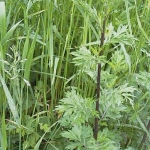| Common Name: | Chinese Moxa |
| Other Names: | Common Mugwort, Felon Herb, Mugwort, Sailor’s Tobacco, St. John’s Plant |
| Botanical Name: | Artemisia vulgaris/center> |
| Genus: | Artemisia |
| Family: | Asteraceae |
| Native Location: | Northern temperate regions. |
| Cultivation: | Well-drained, neutral to slightly alkaline soil in sun. Artemisia absinthium, A. a. ‘Lambrook Silver’, and A. lucoviciana tolerate drought. A. capillaris thrives in moist soil and tolerates light shade. Hardiness varies with species; cover marginally hardy plants with loose straw or overwinter plants under cover. In spring, cut back shrubby species near ground level, or remove dead stems and trim to shape. Rust may attack foliage. |
| Position: | Most species prefer full sun, good drainage and almost neutral soil, (although mugwort tolerates partial shade). As it is strongly insecticidal, use it as a companion plant in the edge of gardens. |
| Propagation: | By seed sown in spring (annuals, perennials, and A. d. subsp. dracunculoides); by semi-ripe cuttings with a heel in summer (shrubby species); by division in autumn or spring (perennials).
Propagate all perennial artemisias by semi-hardwood cuttings taken from midsummer to autumn, or raise from seed. Propagate rhizomatous species by root division in autumn. Directly sow the annual species A. annua into the garden in spring, or raise as seedlings and transplant at 6 weeks. |
| Maintenance: | Lightly prune and shape perennial busy artemisias in spring. Prune southernwood heavily in spring. Artemisias are a drought-tolerant group once they are established, and perennial forms have good frost tolerance. |
| Pests and Diseases: | Wormwoods are rarely troubled by pests and diseases. |
| Harvest: | By seed sown in spring (annuals, perennials, and A. d. subsp. dracunculoides); by semi-ripe cuttings with a heel in summer (shrubby species); by division in autumn or spring (perennials).
Harvest the leaves as required to use fresh or dried. |
| Varieties: | Oriental limelight
Has yellow-variegated foliageVariegated
Has white-flecked foliage. |
| Height: | 60cm-1.7m (2-5½ft) |
| Width: | 30cm-1m (1-3ft) |
| Hardiness: | Z4-10 |
| History: | Muggiwurti, an Old Germanic phrase meaning “insect plant” or “moth plant”, is the origin of mugwort’s common name as well as a reference to the herb’s oldest use—that of repelling moths and other bugs. Despite this very down-to-earth use—or perhaps because of it—until the Middle Ages mugwort was more associated with magic than with medicine. One of mugwort’s most popular medieval names was Cingulum Sancti Johannis, or “Saint John’s Girdle”. The name pays homage to the belief that John the Baptist wore a girdle of mugwort to protect himself from attack by demons while he was wandering the desert. He certainly didn’t wear it to ward off the pesky locust, which legend also tells us he dined on. Still, mugwort became famous for warding off all manner of other pesky evils: hung over your door, it deflected lightning; hidden under your front step, it drove away traveling salesmen; placed on your mantel, it scared off witches and demons; stuffed in your pillow, it gave you the power of precognitive dreams; put in your shoes, it protected you from exhaustion, sore feet, heat stroke, and the occasional evil eye.
By the sixteenth and seventeenth centuries, much of the medieval madness around mugwort’s magical uses had dissipated and the British herbalist John Gerard and Nicholas Culpeper wrote extensively about the herb’s effectiveness in treating anxiety, indigestion, and poor appetite. |
| Parts Used: | Aerial Parts, Leaves (ai ye) |
| Properties: | A bitter, aromatic, tonic herb that acts as a digestive stimulant, diuretic, and nerve tonic, and increases perspiration. It stimulates the uterus and expels intestinal parasites. |
| Medicinal Uses: | Internally for depression with loss of appetite, dyspepsia, threadworm and roundworm infestations, and menstrual complaints (in the West mainly to encourage menstruation; in the East to control uterine bleeding and threatened miscarriage).In traditional Chinese medicine the compressed, dried leaf, known as moxa, is burned briefly on the skin to warm the acupuncture points in cases of internal cold. Used mainly in Ayurvedic medicine for the female reproductive system, nervous complaints, and as a wash for fungal infections. Not given internally to pregnant or lactating women.
Mugwort is used as a digestive stimulant and nerve tonic, and is also used to treat menstrual problems.
Mugwort has antidepressant, appetite-stimulating, calming, digestive, diuretic, sweat-promoting, and tonic properties. It also stimulates the uterus and expels intestinal worms. Mugwort is taken internally for depression, bladder ailments, cramping pain, heavy and scanty menstrual bleeding, indigestion, intestinal worms, menstrual irregularities, poor appetite, stress, and uterine bleeding. Extracts of the fresh leaves are sometimes used externally to treat fungal infections and warts. Mugwort powder may be added to a warm bath to ease rheumatic pain and stiffness. |
| Preparation: | Mugwort is available as dried herb and powder and in capsules, teas, and tinctures. Consult a qualified medical practitioner about the best way for you to take mugwort. |
| Culinary Uses: | One of the more palatable wormwoods, used in traditional recipes (especially in the UK, Germany, and Spain) in dishes of eel or carp, and in stuffings for geese, duck, pork and mutton. Used in China and Japan to flavor and color rice cakes and dumplings. Dried leaves and flowering tops used for tea. |
| Caution: | Do not take mugwort if you are pregnant, nursing, or trying to conceive. Do not exceed recommended dosages. Overconsumption of the herb may result in poisoning. |
| Warning: | Artemisias, and extracts from them, such as cineole and santonin, are subject to legal restrictions in some countries. |
| Bibliography: | Encylopedia of Herbs by Deni Brown Copyright ©: 1995, 2001 Dorling Kindersley Limited pp 130-131, 133-134
The Complete Illustrated Book of Herbs by Reader’s Digest Copyright©2009 The Reader’s Digest Association, Inc. Pg 17
The Modern Herbal Primer by Nancy Burke Copyright©2000 Yankee Publishing, Inc. pp. 82-83 |

